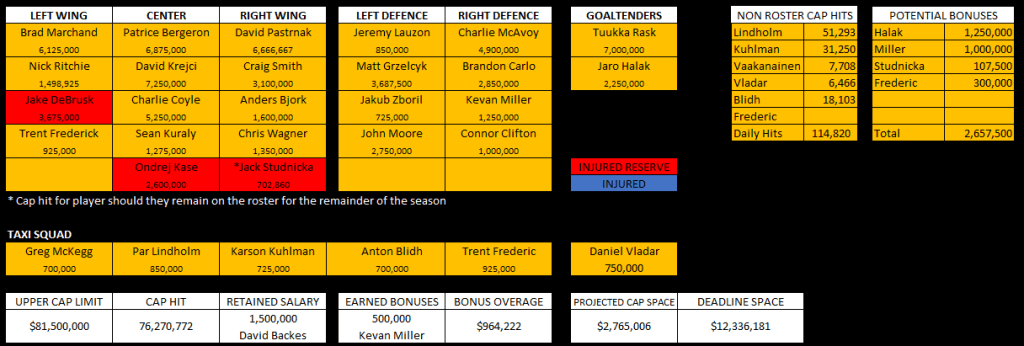Dominic Tiano, the resident expert on most matters CBA-related, provides a quick primer on ways that teams are taking advantage of the existing framework to potentially manipulate the salary cap. You’ve probably seen the chatter on Twitter and social media in general, but “The Dom” breaks it down for the rest of us in a manner that’s easy to understand and provides some ideas to keep this from becoming a growing trend league-wide. -KL
What do Nikita Kucherov, Steven Stamkos, Freddie Andersen, Michael Kempny and Evgeni Malkin have in common?
All have missed significant time (in Kucherov’s case, the entire season) which allowed their teams to exceed the NHL salary cap with the Long-Term Injury Exemption known as LTIR.
The problem is, what their respective teams have done does not break any NHL rules. It’s also allowed those teams to go out on trade deadline and make improvements to their rosters in their quest for the Stanley Cup.
And now, they are all set to return at some point in these playoffs because there is no salary cap in the playoffs.
It gets even stranger.
Alex Steen of the St Louis Blues officially announced his retirement on December 17, 2020 yet the Blues used his entire cap hit of $5,750,000 (and then some) on LTIR.
While there has to be some mechanism in place that allows a team to replace a player who is out with a bona-fide long term injury, the NHL and the NHLPA need to sit down and take a look at what some teams are doing, although the latter may not want a change as it puts more money in the player’s pockets.
How would you feel if the Boston Bruins lost Patrice Bergeron for a season and couldn’t replace him because there was no LTIR?
But the NHLPA may want to look a little closer. You need not go back any further then the 2019-20 season when the Ottawa Senators had a whopping $15 million plus tied up in players on LTIR. Marian Gaborik, Ryan Callahan and Clarke MacArthur never played a game and spent the entire 186 days of the NHL season on LTIR. And even though the Sens never used a penny of that LTIR, what did it accomplish? It got them to the cap floor without spending a penny of Eugene Melnyk’s money because they were paid by insurance. That kept money out of other player’s pockets.
If you could ask any General Manager how they feel about the situation, I would be willing to bet that the overwhelming majority have no issue with it because they know one day, it could be them that need to use that avenue.
But ask the now 32 team owners and you would get a different response because it now actually involves dollars. And none may be more vocal than Chairman of the Board and Bruins Owner Jeremy Jacobs who was one of the leaders of bringing in a salary cap. And he carries a lot of weight.
Chris Johnston of Sportsnet said on a Hockey Night in Canada Broadcast that the League is saying “we’re going to watch you closely.”
Well Gary Bettman, the time has come. The playoffs are here.
I’m not one to defend Bettman and his right-hand man Bill Daly but in fairness, they have done a marvelous job along with the NHLPA and the players to make sure the Stanley Cup was awarded last season and we had some sort of season this year.
And their main concern has been to make sure that we get through the season and that we have a normal season next year. They’ve also had to negotiate two massive (in hockey’s case) American Television contracts.
Again Mr. Bettman, the time has come.
There are no easy fixes, but I will take a stab at it.
This is the way The Dom would rectify it:
1- Even though there is no salary cap in the playoffs, rosters must be cap compliant. You could also set an arbitrary cap like the offseason cap. Make it so teams could go over by 5% to carry their “black aces”.
2- If a player misses an entire season due to being on LTIR, then he is not eligible for the playoffs.
3- You can not trade a player who is on LTIR. Personally, I’ve never understood this. If you can’t buyout a player who is injured, why should you be allowed to trade him?
4- If a player officially retires, there should be no LTIR associated with him.
5- If a player is deemed to have a bona-fide injury and is going to miss 10 games or 24 days (the minimum required to go on LTIR), then the LTIR space allowed is based on the team’s “new” salary cap on the day of the injury. Right now, a team is allowed to make recalls to get as close as possible to the salary cap to maximize LTIR.
Example: With a salary cap of $81.5 million, if a team has a cap hit of $80 million, they can recall player(s) making up to $1.5 million to get to the upper limit. If a player with a $5 million cap hit goes on LTIR, they can then exceed the cap to $86.5 million. Under my scenario, the team’s cap hit on the day of the injury would be used, or $80 million making their new “upper limit” $85 million.
If you have any ideas, post them in the comments below!
Enjoy the Stanley Cup Playoffs!

